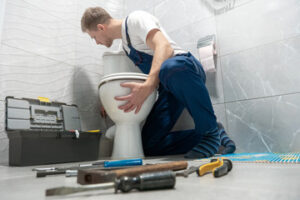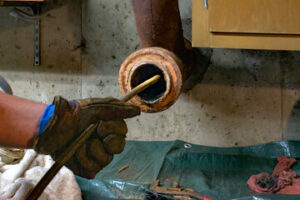Plumbing is an intricate system that requires precise planning for efficient operation and code compliance. This template is designed to help you produce plumbing plans that are clear and reliable, minimizing extra trips to the supply store and costly mistakes.

Specify the pipe sizes on the drain-waste-vent (DWV) riser diagram to ensure proper performance and reduce sewage backups. Check the sump pump discharge line to make sure it moves through its full range of motion without binding or churning. Visit https://www.plumbing-express.com/ to learn more.
One of the most overlooked items on the plumbing inspection checklist is the pit drain. This drain, usually installed in a garden bed or around the foundation of a home, removes water and debris from stormwater runoff. This is crucial for preventing flooding, which can cause damage to furniture and appliances and lead to mold and mildew growth in the home.
The pit drain is typically made of heavy-duty precast concrete or a lighter GRC (glass reinforced concrete). Inspect it to ensure the float activates and the pump is able to discharge properly. Also, check the pit for any silt that might obstruct or clog the float or pump impeller. If you notice a layer of sand at the bottom of the pit, this could indicate sediment is entering the pit from incoming footing and foundation drain lines.
If the float doesn’t activate, inspect the pump for power issues or mechanical failures. If the pump still won’t turn on, a professional should be called for inspection and repair.
A faulty check valve, which keeps wastewater from flowing back into the pit after it’s been pumped out, is another common problem that requires inspection and possible replacement. Checking for obstructions or leaks and cleaning the vent pipe are additional steps to help reduce foul odors and prevent blockages.
Leaks around the house can waste tens of thousands of dollars in water each year, and these leaking pipes often go unnoticed until significant damage is done. By having a plumbing inspection conducted by an experienced plumber, homeowners can catch and fix small problems before they become major issues that cost money.
In addition to performing these routine maintenance tasks, homeowners can help prevent plumbing emergencies by ensuring downspouts direct water away from the foundation and by testing toilet flappers for proper seals. Adding food coloring to a toilet tank and watching for color in the bowl without flushing can also help homeowners identify potential toilet leaks, which should be fixed immediately. A plumbing inspection from Legacy Plumbing can also identify hidden issues that aren’t always visible, like a sewer drain line clogged with tree roots or a blocked stormwater drain.
Clean the Screen
Screens are often the most expensive part of a print shop, so it’s important to keep them clean. This means using a cleaning solution with the right solvents and ensuring that the screen is dried properly. If a screen isn’t properly dried, it may become clogged with ink and lead to poor print quality.
The best cleaner for screens is distilled water. It’s free of additives and won’t damage polymer screens. It’s also important to use a non-abrasive cloth. Using harsh abrasives can scratch the mesh.
During the cleaning process, it’s important to focus on the corners and edges of the screen where ink tends to accumulate. A soft brush or rag can be used to gently scrub the screen, breaking down any stubborn ink residues. After the screen is cleaned, it’s important to thoroughly rinse it with a degreaser. This ensures that any lingering oily residues are removed and doesn’t interfere with future emulsion application.
When rinsing the screen, it’s critical to do so in a dust-free environment. A fan can be used to circulate air, but it should not be directed directly at the screen as this can cause dust particles to get caught in the mesh. After rinsing, it’s important to allow the screen to dry in a dust-free environment. Keeping the screens clean will reduce downtime and prevent costly repairs.
Before cleaning, it’s a good idea to power down the screen to prevent any accidental damage. Next, spray the entire screen with a fine mist of water from a hose. After a thorough rinse, use a PVA chamois towel to dry the screens and the surrounding frames, fiberglass, and buttons. Avoid using a paper towel, as the fibers can scratch the surface of the screen. A final inspection of the screen can reveal any areas that need attention before the next printing session.
Inspect the Discharge Pipe
When it comes to plumbing inspections, the shut-off valve is one of the most important components to check. This is because if the valve isn’t working properly, it could result in serious property damage and safety hazards. The inspector will check the shut-off valve for signs of corrosion, rust, and other issues that could affect its functionality. They’ll also ensure that the valve is the right size for the current system and that it has a handle that’s easy to reach.
Inspecting the discharge pipe is another crucial part of the plumbing inspection process. This is because the pipe is what sends the sewage out of the house, so it’s essential that it’s in good condition. The inspector will inspect the discharge pipe for any signs of clogs or blockages, as well as ensure that it’s made from a material that’s suitable for draining water (such as PVC).
It’s also a good idea to perform an external inspection of all exposed pipes. This is especially important for pipes located in basements or crawl spaces, as they’re more likely to experience damage from moisture and other environmental factors. A professional plumber can help with these inspections, as they have the expertise and tools to get the job done right. They can also recommend any necessary repairs to ensure that the pipes are in good condition for their intended uses.

